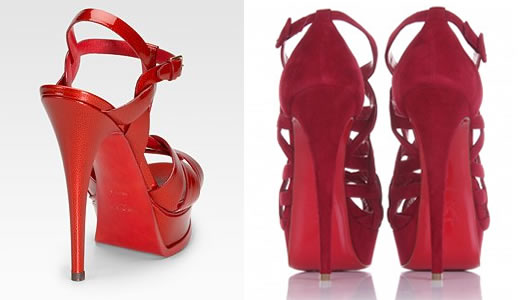Christian Louboutin Sees Red Over Yves Saint Laurent’s Red Soled Shoes, Sues

Can you identify which red sole shoe is YSL, and which is Christian Louboutin?
If you see a flash of red on the bottom of a woman’s shoe, your first thought might be that those shoes are by Christian Louboutin. That’s certainly what Christian Louboutin thinks your first thought will be, because they recently filed a lawsuit against Yves Saint Laurent in Manhattan which claims that “Defendants use of red footwear outsoles that are virtually identical to plaintiff’s Red Sole Mark,” and that the shoes “is likely to cause and is causing confusion, mistake and deception among the relevant purchasing public as to the origin of the infringing footwear.” {NYDN via the Cut}
This is certainly a unique case, given that Yves Saint Laurent isn’t exactly selling shoes at knockoff prices. Loboutin was one of the first designers to use a colored sole to brand his footwear, but should someone be able to trademark or copyright the placement of a color?
In the photo above, the color of the sole on the Yves Saint Laurent tribute sandal (left) does look a shade different from the color of the sole on the Christian Louboutin sandals (right). Â It’s worth noting that the Yves Saint Laurent shoes are part of a collection that includes yellow sandals with a yellow sole, and the Cut says that the collection these shoes are from also includes navy shoes with navy soles, green shoes with green soles, etc.
The slight difference in shade might be a matter of photography and lighting though, and to someone who’s not an avid fashion fan, it’s not difficult to believe that someone could mistake the Yves Saint Laurent shoes for a pair of Louboutins based on the sole coloring. At $795 (the price of the YSL tribute sandals pictured), that doesn’t dilute the Louboutin brand in the same way that a $100 exact replica might, but it could certainly harm the positioning of red soled shoes being something exclusive to Christian Louboutin.
While we can certainly see, and support, Louboutin’s position in this case, we also have to wonder if it might set a bad precedent. Will Chanel be able to sue bag makers who create quilted leather goods? That wouldn’t just include counterfeiters, it would make Marc Jacobs and plenty of established fashion designers susceptible to punishment as well. When dots begin to take over fall wardrobes, will one designer decide that another’s look too similar to theirs?
Should this actually make it to court, we’ll be tracking the decision.
